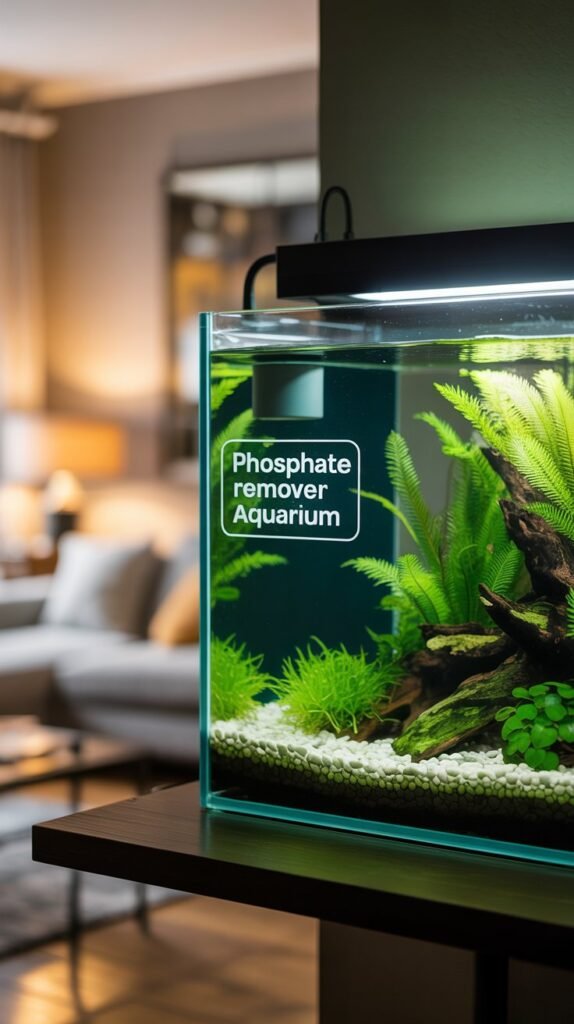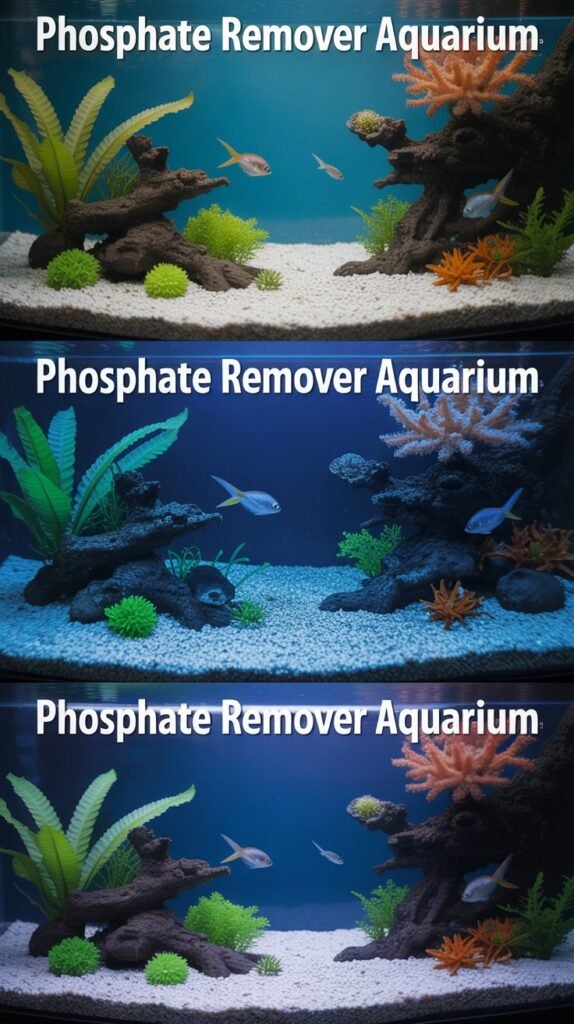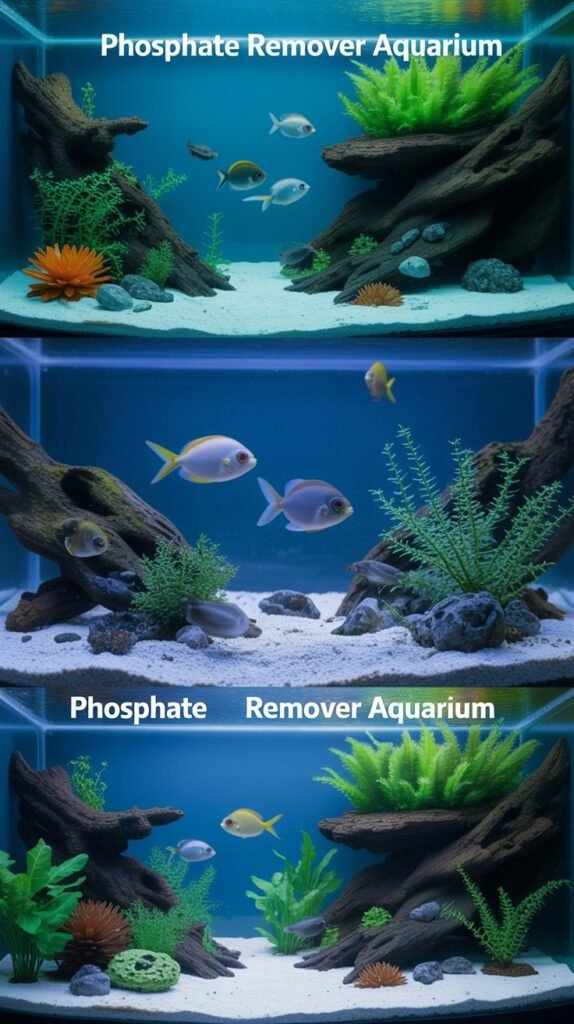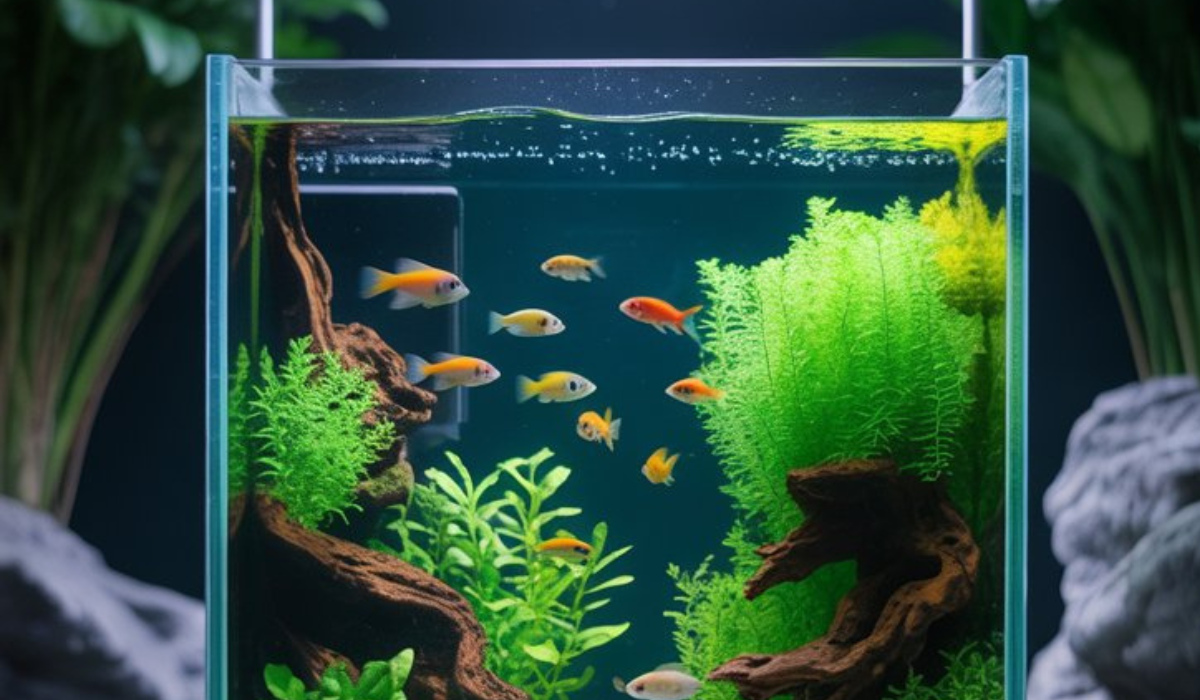Aquarium keeping is a rewarding hobby, but maintaining water quality can be a challenge. Among the many water parameters aquarists monitor, phosphate levels are often overlooked. While phosphates may not be toxic to fish in small amounts, excess levels can fuel algae growth, disrupt the balance of planted tanks, and stress aquatic life. That’s where phosphate remover aquarium products come in. These solutions help control phosphate levels and maintain a clean, stable aquatic environment
In this guide, we’ll cover everything you need to know about phosphate removers for aquariums. From understanding what phosphates are and where they come from, to the different types of phosphate removers available, and step-by-step guidance on how to use them effectively, you’ll find a complete resource here. Whether you are a beginner aquarist or an experienced hobbyist, managing phosphate is key to a thriving aquarium
What Are Phosphates in Aquariums?
Phosphates (PO₄) are a natural part of the nitrogen cycle in aquariums. They are byproducts of organic waste breakdown, including fish waste, uneaten food, and decaying plant matter. While low phosphate levels (below 0.5 ppm) are generally harmless, high concentrations can cause multiple problems in aquariums
Effects of high phosphate levels include:
- Accelerated algae growth, especially green hair algae and brown diatoms
- Cloudy or discolored water
- Stress for sensitive fish and invertebrates
- Poor plant health, since algae outcompete plants for nutrients
- Reduced oxygen levels at night due to excess algae respiration

Monitoring phosphate is just as important as checking ammonia, nitrite, nitrate, and pH. Many aquarists use test kits to keep levels in check and rely on phosphate removers when values exceed safe limits
Sources of Phosphates in Aquariums
To effectively manage phosphate, it’s important to understand where it comes from. Common sources include:
- Overfeeding – Excess food decomposes, releasing phosphate into the water
- Fish Waste – Naturally produces phosphates as it breaks down
- Decaying Plants – Dead leaves contribute phosphate buildup
- Tap Water – Some municipal water supplies contain phosphate additives to prevent pipe corrosion
- Poor Quality Fish Food – Foods with high levels of phosphate-based preservatives release extra nutrients into the tank
- Filter Media Buildup – Trapped organic waste in filters can increase phosphate if not cleaned regularly
By identifying these sources, aquarists can take preventive measures in addition to using phosphate removers
What Is a Phosphate Remover for Aquariums?
A phosphate remover aquarium product is a material or chemical treatment designed to reduce or eliminate phosphate from aquarium water. These removers work by binding phosphates, absorbing them, or chemically neutralizing them. They are available in different forms, including filter media, liquid treatments, and resins
Using phosphate removers helps:
- Keep algae under control
- Improve water clarity
- Create healthier conditions for fish and plants
- Stabilize overall tank chemistry
They are commonly used in freshwater, planted, and marine aquariums, where phosphate control is critical for coral and plant health
Types of Phosphate Removers
There are several types of phosphate removers available for aquariums, each with its own advantages
1. Granular Ferric Oxide (GFO)
- One of the most popular phosphate removers for reef and marine tanks
- Binds phosphates and silicates effectively
- Available as loose media that can be used in filter bags or media reactors
- Long-lasting and effective for controlling algae outbreaks
2. Aluminum Oxide-Based Media
- Works by binding phosphates chemically
- Useful in both freshwater and saltwater tanks
- Acts quickly but may need frequent replacement
- Some sensitive corals may react negatively if used in excess
3. Resin-Based Phosphate Removers
- Synthetic resins specifically designed to absorb phosphate
- Often reusable after regeneration with salt solutions
- Suitable for both freshwater and marine aquariums
4. Liquid Phosphate Removers
- Usually based on lanthanum chloride or similar compounds
- Precipitates phosphate, allowing it to be removed through filtration
- Works quickly, ideal for emergency phosphate reduction
- Should be used with caution to avoid sudden parameter swings
5. Phosphate-Absorbing Filter Pads
- Easy-to-use pads placed in filters to trap phosphate
- Ideal for small aquariums or beginner setups
- Less powerful than GFO or resins but convenient for maintenance
Each type has its place depending on your tank setup, livestock, and maintenance preferences
How to Use Phosphate Removers in Aquariums

Phosphate removers are effective, but proper usage ensures best results. Here’s a step-by-step guide:
- Test Phosphate Levels – Use a reliable phosphate test kit to measure concentration before adding a remover
- Choose the Right Remover – Select a type that suits your tank (e.g., GFO for reef tanks, pads for small community tanks)
- Place in Filtration System – For media-based removers, put them in filter bags, canister filters, or reactors for maximum contact with water flow
- Monitor Water Parameters – Retest phosphate levels after 24–48 hours to gauge effectiveness
- Replace When Saturated – Most phosphate removers have a lifespan of 2–6 weeks depending on load. Replace or recharge as needed
- Combine With Maintenance – Regular water changes, reduced feeding, and cleaning filters enhance effectiveness
Best Practices for Managing Phosphates
Using phosphate removers is effective, but long-term control requires good aquarium habits. Here are some best practices:
- Avoid Overfeeding: Feed small amounts that fish consume within a few minutes
- Perform Regular Water Changes: 20–30% weekly water changes help dilute phosphate levels
- Use RO/DI Water: For marine and planted tanks, reverse osmosis water prevents phosphate introduction from tap water
- Maintain Filtration: Clean filters regularly to prevent organic buildup
- Choose High-Quality Fish Food: Look for brands with low phosphate preservatives
- Add Live Plants: In freshwater tanks, plants absorb phosphates as part of their growth cycle
- Control Algae: Manual removal of algae helps reduce phosphate cycling in the tank
When combined with phosphate removers, these habits create a balanced aquarium ecosystem
Benefits of Phosphate Removers
Investing in phosphate remover aquarium products provides several benefits:
- Algae Control – Prevents unsightly algae blooms and keeps tanks visually appealing
- Improved Water Quality – Clearer water enhances fish and coral health
- Healthy Plant Growth – Prevents algae from outcompeting plants for nutrients
- Coral Health in Reef Tanks – Keeps phosphate at safe levels for sensitive corals and invertebrates
- Low Maintenance – Reduces frequency of cleaning and scrubbing algae from surfaces
- Prevention of Imbalances – Helps stabilize overall aquarium chemistry
Choosing the Right Phosphate Remover

When selecting a phosphate remover, consider these factors:
- Tank Type – Marine tanks often require stronger removers like GFO, while freshwater setups may do fine with pads or resins
- Tank Size – Large aquariums benefit from bulk media in reactors, while small tanks work well with pads or liquid treatments
- Budget – GFO and resins are more costly but last longer, while pads and liquid treatments are cheaper but require frequent replacement
- Livestock Sensitivity – Corals, shrimp, and delicate fish may react to certain chemical removers, so research compatibility before use
Common Mistakes to Avoid
While phosphate removers are helpful, improper use can create problems. Avoid these mistakes:
- Relying Solely on Removers – They should supplement, not replace, good tank maintenance
- Using Too Much at Once – Sudden drops in phosphate can stress fish and corals
- Not Testing Levels – Blind dosing leads to overuse or inefficiency
- Neglecting Water Changes – Phosphate removers won’t solve poor maintenance practices
- Ignoring Food Quality – Feeding cheap, phosphate-heavy food adds to the problem
Balanced aquarium care always yields the best results
Do Planted Aquariums Need Phosphate Removers?
Interestingly, not all phosphate is harmful. In planted aquariums, phosphate is actually a macronutrient essential for plant growth. However, excess phosphate leads to algae outbreaks. For planted tanks, the goal is balance, not elimination. Phosphate removers can be used sparingly if levels get too high, but aquarists should avoid stripping all phosphate from the water, as it can starve plants
Do Marine Aquariums Need Phosphate Removers?
In marine and reef aquariums, phosphate control is critical. Corals and other invertebrates are sensitive to elevated phosphate levels. High phosphate inhibits calcification, meaning corals struggle to build skeletons. Reef keepers commonly use GFO or resins in reactors to maintain ultra-low phosphate levels, often below 0.03 ppm
Conclusion
Managing phosphate is essential for a healthy, balanced aquarium. Excess phosphate fuels algae growth, reduces water quality, and stresses aquatic life. Phosphate remover aquarium products provide an effective solution, but they should be paired with proper feeding, water changes, and filtration. With options like GFO, resins, pads, and liquids, aquarists can choose the method that best suits their setup. Whether you keep freshwater plants or delicate corals, phosphate management is a key part of long-term aquarium success
FAQs About Phosphate Remover Aquarium
1. What is the safe phosphate level in aquariums?
For freshwater aquariums, levels below 0.5 ppm are safe. For reef aquariums, keep levels below 0.03 ppm
2. Can phosphate removers harm fish?
When used correctly, phosphate removers are safe. Overuse or sudden phosphate drops may stress sensitive fish or corals
3. How often should I replace phosphate remover media?
Typically every 2–6 weeks, depending on phosphate load and aquarium size
4. Do live plants remove phosphate?
Yes, live plants absorb phosphate as part of their natural growth process
5. Can I use phosphate removers in a planted aquarium?
Yes, but use sparingly. Plants need some phosphate, so avoid stripping it completely
6. Do phosphate removers also remove nitrates?
Most only target phosphates, though some resins may also reduce silicates or nitrates depending on the brand
7. Are liquid phosphate removers safe for reef tanks?
Yes, but they must be dosed carefully to avoid sudden chemical changes
8. Does tap water contain phosphate?
In some areas, yes. Using RO/DI water helps eliminate this source of phosphate
9. Can overfeeding cause high phosphate levels?
Yes, uneaten food is one of the main contributors to phosphate buildup
10. Do I still need water changes if I use a phosphate remover?
Yes, phosphate removers are supplemental. Regular water changes remain essential for overall water quality

